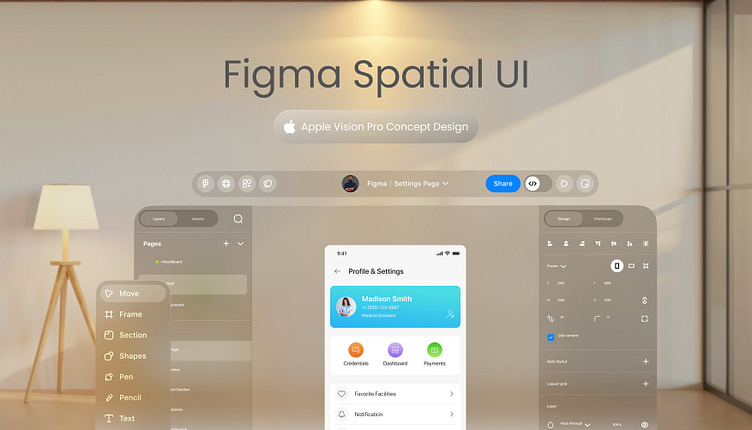Figma Spatial UI: Apple Vision Pro Concept Design
Creating a Figma Spatial UI utilizing Apple Vision Pro Concept Design involves integrating the principles of spatial design with the aesthetic and functional elements inspired by Apple's vision.
Understanding Spatial Design:
Spatial design focuses on how users perceive and navigate through digital spaces. It involves creating interfaces that simulate real-world environments, enhancing user immersion and interaction.
Apple Vision Pro Concept Design:
Apple's design philosophy emphasizes simplicity, elegance, and intuitive user experiences. The Vision Pro concept likely incorporates cutting-edge technology, sleek aesthetics, and seamless integration across devices.
Integration of Spatial Design Principles:
Depth and Layering: Utilize depth cues such as shadows, perspective, and layering to create a sense of depth and hierarchy within the UI elements. This helps users understand the spatial relationships between different elements.
Spatial Navigation: Implement intuitive spatial navigation techniques, such as 3D gestures or spatial audio cues, to guide users through the interface seamlessly.
Responsive Environments: Design interfaces that adapt to users' actions and movements, creating dynamic and responsive digital environments that mimic real-world interactions.
Figma Integration:
Figma is a collaborative interface design tool, and integrating spatial design principles into its UI involves enhancing its capabilities for creating immersive and interactive experiences.
3D Workspace: Introduce a 3D workspace within Figma where users can arrange and interact with design elements in a spatially-aware environment. This allows for more intuitive manipulation and organization of UI components.
Spatial Gestures: Incorporate spatial gestures, such as pinch-to-zoom or swipe-to-rotate, to enable users to navigate and manipulate the 3D workspace effortlessly.
Real-time Collaboration: Enhance Figma's collaborative features to support real-time interaction within the spatial environment, enabling multiple designers to work together seamlessly in a shared virtual space.
Apple Design Language:
Infuse the UI with design elements inspired by Apple's aesthetic, such as clean typography, minimalist icons, and subtle animations. Maintain consistency with Apple's design language while adapting it to the spatial UI paradigm.
Accessibility and Usability:
Ensure that the spatial UI remains accessible and usable for all users, including those with disabilities. Consider factors such as color contrast, text legibility, and alternative navigation methods to accommodate diverse user needs.
User Testing and Iteration:
Conduct extensive user testing to gather feedback on the spatial UI concept, iteratively refining the design based on user insights and preferences. Continuously iterate and improve the design to enhance usability and user satisfaction.
By integrating spatial design principles with Apple's design philosophy and leveraging Figma's collaborative capabilities, the Figma Spatial UI using Apple Vision Pro Concept Design aims to redefine the way designers create and interact with digital interfaces, ushering in a new era of immersive and intuitive design experiences.


